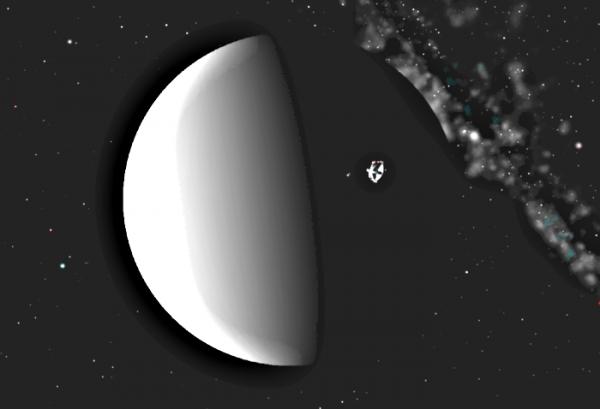BY LETTER
Hedrile
 Image from Steve Bowers |
The Hedrile is an alien artifact found orbiting the K-type star Charonis in the Outer Volumes. It is a sphere approximately 10,000 km in diameter. It was discovered by a conversion drive equipped hyperturing probe launched by the Solar Dominion in 9947. Upon further investigation, it was discovered that the Hedrile was made up of billions of triangular faces, each one metre on a side. In the middle of each triangular face is a diamondoid hemisphere about 10cm across with indecipherable writing engraved into it. As of the current era, the writing has eluded explanation.
The surface material (except for the diamondoid hemispheres) has varying reflectivity. At one point on the Hedrile's surface, the surface is 100% reflective. At the antipodal point, it is 100% absorbent of electromagnetic emissions. Skeptics have pointed out that this would cause uneven radiation pressure, which would thus make the Hedrile fly off into space. And so it is, but very slowly. In fact, it is moving away from Charonis at 0.1% the rate predicted by ordinary light-pressure calculations. This has been said to be consistent with a majority theory among transapients that the Hedrile is a new class of wormhole metric.
It has been found out that the Hedrile blocks neutrinos, making it either impossibly dense or something new altogether. This has also been said to be consistent with the wormhole theory, as is has been suggested that the neutrinos are not being blocked, but instead traveling to the other end. The location of the other end is a mystery, as no other Hedrile has been found in the Terragen Sphere. It might be, as hyperturing philosopher Tangency Fint believes, in another universe entirely. It has been observed that the surface has no gravity, despite the fact that spaceships can go into orbit around it. This was investigated thoroughly, and found that until about 50 kilometres above its surface, spacetime has zero curvature, but above 50 km, spacetime adopts the standard metric for a spherical body.
Since the discovery of the Hedrile at least one other long-distance alien wormhole has been discovered, the so-called Fargate; this hole is traversable safely, and seems to be of an entirely different type. Yet another is believed to have been destroyed in 10040 near Arkab Prior following the assassination attempt on the Blessed Fluke. But these Fargates have, or had, an entirely different geometry from the Hedrile.
Based on gravitational calculations made from results taken from outside the 50 km perimeter it has been found that the Hedrile has a mass equivalent to half the Earth's. It is rumored that five SI:2 transapients from the Solar Dominion attempted to try and unravel the mystery, but four of them vanished without a trace. The last one remains in the Charonis system for observation. The last recorded transmission from the four vanished transaps read*:
platform 137: What do you see?
Probegroup: The last-
(transmission cuts out)
- Please note: message roughly translated to baseline-friendly version.
Following the loss of 4 SI:2 transapients, the Lord of Rays banned any Solar Dominion excursions to the Hedrile. However, other factions may pursue research. The Eternal and the Archosaurian Entity have both launched numerous expeditions to the Hedrile, but nothing new has been discovered. There are now a few science stations in orbit around the Hedrile, equipped with hundreds of finely-tuned sensors ready to pick up the slightest deviation from normality (whatever that is).
Appears in Topics
Development Notes
Text by Loopquanta
Initially published on 19 January 2007.
Initially published on 19 January 2007.






